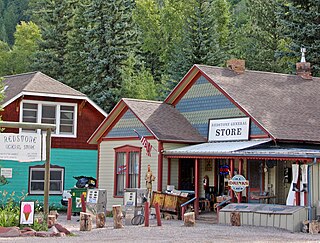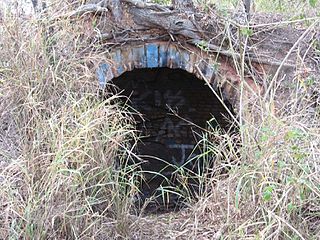
Coke is a grey, hard, and porous fuel with a high carbon content and few impurities, made by heating coal or oil in the absence of air—a destructive distillation process. It is an important industrial product, used mainly in iron ore smelting, but also as a fuel in stoves and forges when air pollution is a concern.

Chickamauga is a city in Walker County, Georgia, United States. The population was 3,101 at the 2010 census. It is part of the Chattanooga, TN–GA Metropolitan Statistical Area.

Leetonia is a village in Salem Township, Columbiana County, Ohio, United States. The population was 1,959 at the 2010 census. Leetonia is located in the Salem, OH Micropolitan Statistical Area, as well as the southern part of the greater Mahoning Valley.

The New River Gorge National Park and Preserve is a unit of the United States National Park Service designed to protect and maintain the New River Gorge in southern West Virginia in the Appalachian Mountains. Established in 1978 as a national river, the NPS-protected area stretches for 53 miles (85 km) from just downstream of Hinton to Hawks Nest State Park near Ansted. The park was officially named America's 63rd national park, the U.S. government's highest form of protection, during the COVID-19 pandemic as part of the relief bill.

Star Junction is an unincorporated community and census-designated place in Perry Township, Fayette County, Pennsylvania, United States. The community is located on Pennsylvania Route 51. At the 2010 census, the population was 616.

The Elkins Coal and Coke Company Historic District is a historic industrial site near the crossroads village of Bretz in Preston County, West Virginia. It is the site of the last major coke manufacturing facility to use beehive ovens, and was a major industrial site in northern West Virginia in the first half of the 20th century. Surviving elements include a row of 140 beehive ovens. The site was declared a National Historic Landmark in 1983.

Pocahontas Exhibition Coal Mine, also known as Pocahontas Mine No. 1, or Baby Mine, is an inactive coal mine in the Pocahontas Coalfield, near Pocahontas in western Virginia. The mine was the first in the sub-bituminous coal of the Pocahontas Coalfield, opening in 1882. In 1938 it became the first exhibition coal mine in the United States. Uniquely, it was possible to drive one's automobile through the mine, entering through the fan opening and exiting through the original entry. The practice continued until 1970, when it was discontinued due to damage to the roof of the mine from car exhaust.

Ottovale coke works was a large industrial complex situated at Blaydon Burn, near Blaydon-on-Tyne, Gateshead, North East England. The complex comprised a coke works, tar works and a power station. Built on the site of Dockendale Hall in 1904, it was operated by the Priestman Collieries until the 1970s.

Kay Moor, also known as Kaymoor, is the site of an abandoned coal mine, coal processing plant and coal town near Fayetteville, West Virginia. The town site is located in the New River Gorge at Kaymoor Bottom (38°03′00″N81°03′17″W). It is linked to the mine portal 560 feet (170 m) above on Sewell Bench (38°02′52″N81°03′58″W) in the wall of the Gorge by conveyors.

The Nuttallburg Coal Mining Complex and Town Historic District is located near Winona, West Virginia in New River Gorge National Park and Preserve. The townsite is almost directly across from the Kay Moor mine and townsite, now abandoned. Like Kay Moor, the town is built around the railroad line at the bottom of the gorge, with an array of coke ovens and mining structures, as well as a bridge across the New River to South Nuttall.

Lonaconing Furnace, also known as The George's Creek Coal and Iron Company Furnace No. 1, is a historic iron furnace in Lonaconing, Allegany County, Maryland, United States. It is a truncated square pyramid constructed of sandstone, 50 feet (15 m) high, 50 feet square at the base, and 25 feet square at the top. It first produced iron in 1839, then the iron operation was abandoned in the mid-1850s, the Loncaconing Furnace complex included a top house, molding house, engine house, and two hot-air furnaces for heating the blast. None of these ancillary structures remains. It played a significant role in demonstrating that both coke and raw bituminous coal could be used as fuels in the manufacture of iron. It is known as "the first coke furnace, whose operation was successful, erected in this country."

The Dunlap coke ovens are the remnants of a coke production facility near Dunlap, in the U.S. state of Tennessee. Built in the early 1900s, the facility consists of five batteries of 268 beehive ovens, which operated under various companies until the early 1920s. The ovens are now listed on the National Register of Historic Places, and are maintained by the Sequatchie Valley Historical Society as part of Dunlap Coke Ovens Park.

Bhilai is a city in the Indian state of Chhattisgarh, in eastern central India. With a population of 1,064,077, Bhilai–Durg is the second largest area after Raipur in the Indian state of Chhattisgarh. Bhilai is a major industrial city in India as well as an education hub of central India.

The Redstone Coke Oven Historic District is located at the intersection of State Highway 133 and Chair Mountain Stables Road outside Redstone, Colorado, United States. It consists of the remaining coke ovens built at the end of the 19th century by the Colorado Fuel and Iron Company. In 1990, it was recognized as a historic district and listed on the National Register of Historic Places.

The Redstone Historic District is located in and near the unincorporated community of that name in western Pitkin County, Colorado, United States. It includes the original community of Redstone as built by Colorado Fuel and Iron (CFI) for the coal miners it employed. In 1989 it was recognized as a historic district and listed on the National Register of Historic Places.

The Cherry Valley Coke Ovens consisted of 200 coke ovens built by the Leetonia Iron and Coal Company around 1866, near Leetonia, Ohio, United States. The function of the "beehive" coke ovens was to purify coal and turn it into coke. The coke was burned in furnaces that produced iron and steel.

The Grand Tower Mining, Manufacturing and Transportation Company Site is a 23-acre (9.3 ha) industrial site located in Devil's Backbone Park in Grand Tower, Illinois. The site was operated by the Grand Tower Mining, Manufacturing and Transportation Company, a mining and industrial company which operated in Illinois in the 1860s and 1870s. The furnaces at the site were used to produce coke, a fuel produced from the coal used in iron smelting. The coke produced at the site was likely shipped to an iron furnace 1 mile (1.6 km) south of the site. The site also includes the remains of the superintendent's house; a local legend claims that the house is haunted by the superintendent's daughter.

Klondyke Coke Ovens are heritage-listed beehive ovens at Parker Lane, Brassall, City of Ipswich, Queensland, Australia.It is also known as Klondyke Beehive Coke Ovens and Klondyke Coking Ovens. It was added to the Queensland Heritage Register on 3 December 2007.

The Cokedale Historic District, in Cokedale, Colorado, is a 450 acres (1.8 km2) historic district which is roughly bounded by Church, Maple, Pine, Elm, and Spruce Streets. It was listed on the National Register of Historic Places in 1985. The listing included 92 contributing buildings, seven contributing structures, and two contributing sites.

Monckton Coke Works was a coking plant near Royston in South Yorkshire, England. The plant opened in 1884 and was closed 130 years later in 2014, being one of the last remnants of the coal industry in Yorkshire. In the 21st century, it was known as being the last independent coke works in the United Kingdom. For many years it was known for its high-quality coking coal, even being exported to coal-rich South Africa for use in steelmaking. However, in 2013/2014, the market was swamped with cheap imports from the Far East, spelling the demise of Monckton due to it being uneconomical.






















